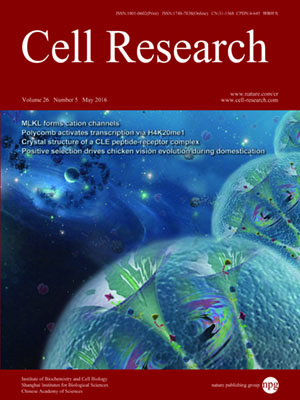
Volume 26, No 5, May 2016
ISSN: 1001-0602
EISSN: 1748-7838 2018
impact factor 17.848*
(Clarivate Analytics, 2019)
Volume 26 Issue 5, May 2016: 613-628
ORIGINAL ARTICLES
TRIM9 short isoform preferentially promotes DNA and RNA virus-induced production of type I interferon by recruiting GSK3β to TBK1
Yunfei Qin1,*, Qingxiang Liu1,*, Shuo Tian1,*, Weihong Xie2, Jun Cui1,3 and Rong-Fu Wang4,5,6
1Key Laboratory of Gene Engineering of the Ministry of Education, State Key Laboratory of Biocontrol, School of Life Sciences, Sun Yat-sen University, Guangzhou, Guangdong, China
2Zhongshan School of Medicine, Sun Yat-sen University, Guangzhou, Guangdong, China
3Collaborative Innovation Center of Cancer Medicine, Sun Yat-sen University, Guangzhou, Guangdong, China
4Houston Methodist Research Institute, Houston, TX 77030, USA
5Department of Microbiology and Immunology, Weill Cornell Medical College, Cornell University, New York, NY 10065, USA
6Institute of Biosciences and Technology, College of Medicine, Texas A & M University, Houston, TX 77030, USA
Correspondence: Rong-Fu Wang, E-mail: rwang3@tmhs.org; Jun Cui,(cuij5@mail.sysu.edu.cn)
Type I interferon (IFN) is an important component of antiviral innate immune signaling mediated by viral DNA and RNA recognition by the DNA sensor cGAS and RNA sensors RIG-I and MDA5. Activation of these DNA and RNA sensors leads to the recruitment of STING and MAVS, respectively, and converges on TANK-binding kinase 1 (TBK1) signaling for subsequent phosphorylation of IFN regulatory factor 3 (IRF3). However, the mechanisms that control TBK1 activation are still poorly defined. Here, we identify tripartite motif 9 short isoform (TRIM9s) as a positive regulator in type I IFN signaling. Upon viral infection, TRIM9s undergoes Lys-63-linked auto-polyubiquitination and serves as a platform to bridge GSK3β to TBK1, leading to the activation of IRF3 signaling. Interestingly, we found that TRIM9s selectively inhibits the production of pro-inflammatory cytokines, but enhances the expression of type I IFNs as well as IFN-stimulated genes, in response to viral infection. Our findings reveal novel dual functions of TRIM9s in antiviral immunity, which serve to balance pro-inflammatory response and production of type I IFNs.
10.1038/cr.2016.27
FULL TEXT | PDF
Browse 2369


